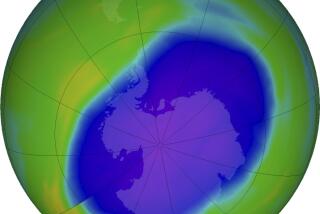Experts Not Making Special Recommendations on Skin Cancer Risk
- Share via
Dermatologists and cancer experts are concerned about the potential increase in skin cancer that would be caused by ozone depletion, but they are not yet offering any special precautions.
“We’re not contemplating scaring people,” said Frank Mahaney of the National Cancer Institute. “Our general recommendations are the same ones we offer every summer--cover up and use a sun block,” he said.
Of all the potential hazardous effects of ultraviolet radiation, scientists know the most about cancer. “Skin cancer is an environmental disease, and ultraviolet light is the cause,” said Irving Rimer of the American Cancer Society.
The mildest forms of skin cancer, like that removed from President Reagan’s nose, are so common that no one keeps track of them. But the cancer society estimates that more than 500,000 new cases develop each year, with 2,000 deaths. Experts agree that the incidence is increasing--primarily because more people are moving to the Southwest and Southeast and spending more time in the sun.
Against this large backdrop, experts say, it will be virtually impossible to detect an increase due to ozone depletion.
Figures are kept for the more severe form of skin cancer called malignant melanoma. Its incidence has been growing about 3.4% a year for the last decade, and about 27,300 new cases are expected in 1988. It has an 80% cure rate if it is caught in the early stages, according to dermatologist John Di Giovanna of the National Cancer Institute.
The risk of contracting either form varies with the individual. Those with light skin or have a family history of skin cancer are most susceptible and should take the most precautions, he said.
Susceptible individuals should wear long-sleeved shirts and wide-brimmed hats and use sun blocker with a high “sun protective factor” on exposed areas. Those who are less susceptible should use a sun blocker with a lower sun protective factor, which is listed prominently on the label.
“It’s not safe to get a dark tan, but it is even worse to get a sunburn,” Di Giovanna cautioned. Repeated sunburn greatly increases the risk of developing melanoma, he said.
Scientists know much less about other biological effects of ultraviolet radiation. To learn more, the National Science Foundation sent 290 investigators to Antarctica during the past summer (winter in the Northern Hemisphere) to conduct 69 different projects. No results are available yet, according to NSF spokeswoman Elizabeth Tait.
The NSF was concerned about the health of the investigators because of the large ozone depletion over Antarctica, Tait said. Fortunately, though, the cold weather meant that their bodies would be thoroughly covered. The agency did, however, equip them with ultraviolet-screening goggles and copious amounts of sun block.
More to Read
Sign up for Essential California
The most important California stories and recommendations in your inbox every morning.
You may occasionally receive promotional content from the Los Angeles Times.













